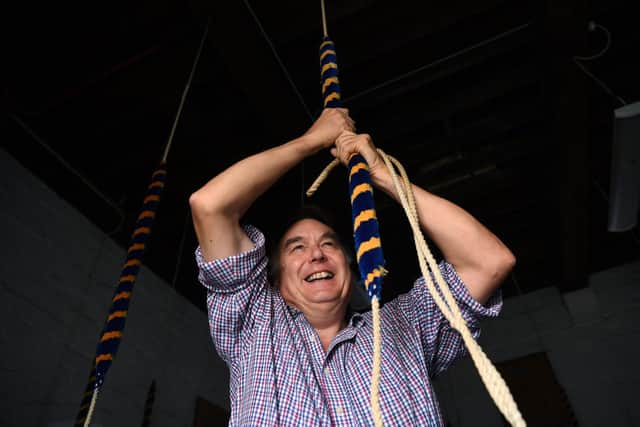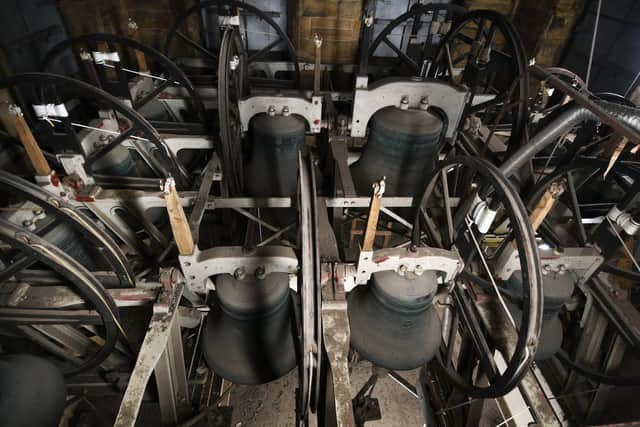Bellringers to attempt astonishing feat from 200 years ago which saw new records set in Wakefield
Yet that is what Joseph Tebbs had likely done, day after day, in a cutthroat rivalry with bellringers in Huddersfield to see who could accomplish the greatest feat.
Mr Moreton is reminded of it every time he rings the bells at Wakefield Cathedral, as his own father did before him, by Tebbs' names on a plaque that hangs on the tower wall.
Advertisement
Hide AdAdvertisement
Hide AdToday is to mark 200 years since bellringers here rang the first ever Cambridge Surprise Royal, an astonishing feat featuring 5,400 changes over 3 hours and 35 minutes.


Now, today's ringers are to attempt to recreate it.
"This was the first time the Cambridge Surprise Royal had been rung anywhere," said Mr Moreton. "Today's anniversary marks an important milestone.
"My father was here at Wakefield, before me," he added. "He often said he regretted missing the 150th anniversary. We've been planning this for a year."I've had this date etched in my brain for 25 years. That plaque is there, as a reminder, every time I ring."
The word Royal in the peal name means 10 bells. On eight it would be a Minor, 12 would be Maximus. It's the word 'Surprise' that gives a hint at how hard this might have been.
Advertisement
Hide AdAdvertisement
Hide Ad

Back in 1822, playing a Cambridge Surprise on 10 bells was unheard of.
"Nobody had rung anything like this before," said Mr Moreton. "They were way ahead of their time - they were trailblazers."
It started with a rivalry, between bellringers in Wakefield and Huddersfield. The latter had rung the peal in minor - with eight bells - in 1820.
So Wakefield set its heart on 10 bells, on October 26 1822, to better them once more.
Advertisement
Hide AdAdvertisement
Hide Ad"The rivalries in those days were quite intense," conceded Mr Moreton. "It might have been the end of it but, having pushed the boundaries, nobody else did it for another 70 years."
These days Cambridge Surprise Royal, as a peal, is more common. Technology means it's fairly simple to compose - compared to 1822 when it would have been pen and paper.
In the tower at Wakefield, ringers have been practicing for today's attempt which will begin at 2.30pm, and could take up to four hours.
The cathedral has 14 bells, with the heaviest cast in 1947 at nearly 1,800kg. The smallest is a quarter tonne. But while that is a lot of heavy metal "hanging over your head", said Mr Moreton, it isn't physically taxing - the training comes into its own with timing.
Advertisement
Hide AdAdvertisement
Hide AdThe rules are quite strict, and complicated. There are 'changes', which today are called 'rows', and means ringing the bells consecutively, one after another, in different permutations. But there are thousands of changes, and anything could go wrong.
A frayed rope could be all it takes, or a broken clapper.
"This is non-stop, we don't get a break every hour," said Mr Moreton. "We just have to keep going. And following a pattern, if you fall off, it all collapses.
"That's what ringing is. Working with a team, practicing the best you can."
As to the why, Mr Moreton keeps coming back to that plaque, replaced 25 years ago, and the names of the 10 men who managed this astonishing feat two centuries ago.
Advertisement
Hide AdAdvertisement
Hide AdThere are nine names from Wakefield, including James and Joseph Gill, who might have been brothers, or maybe father and son.
And Joseph Tebbs, of Leeds, who might have caught a horse and cart but more likely walked.
"They would have practiced, this isn't something you can just 'do'," he said. "He would have come many times.
"It would have been an absolute expedition to get to Wakefield to ring this peal - and then to just go home again. It amazes me, that they did that."
Advertisement
Hide AdAdvertisement
Hide AdToday, the tables are turned. Eight bell ringers are borrowed from Leeds, while there will be two from Wakefield.
From outside the tower, people in the city centre might hear the bells and think it strange on a Wednesday afternoon in October. Inside, they are recreating history.
"Bell ringing is very English," said Mr Moreton. "It's not a worldwide thing - there are 6,000 churches with bells in the world and 5,400 of them are in England.
"It might or might not work," he added. "Things can go wrong. I hope they don't. I'm guessing it will take us around three hours and 50 minutes. Then we will go for a beer."